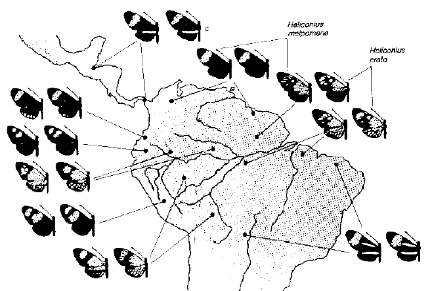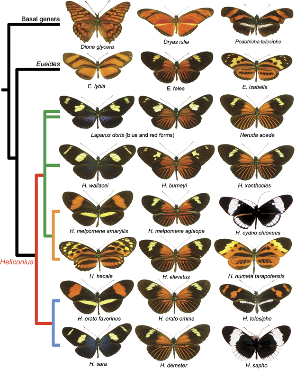Batesian Copycats and Mullerian Mimics
Biology 342 Fall 08
Marisa Mirviss and Molly Radany
Phylogeny
To better understand the existence of such fantastic adaptations as belong to the hawk-moth caterpillar, the anglerfish, and the alligator snapping turtle, we must look at the evolutionary patterns of mimicry as a whole.
We must ask the question:
Where did the mimics come from?
Phylogeny of Müllerian mimicry
The classical conception of Müllerian mimicry rather closely resembles other forms of mutualism exhibited between several species. The theory proposed by Müller constituted a “strength in numbers” advantage to the species involved, which all exhibit a common warning sign. Predation is thus reduced on each of the species by “sharing out the per-capita mortality incurred during predator education” [7].
Here's the formula: Species A is genetically inclined to build a house of straw. Species B is inclined to build one of sticks. Species C has somehow obtained the adaptation of using bricks to build its house. The Big Bad Predator comes along, blows over the houses A and B built, eats most of their species, but can't deal with the bricks, so he leaves species C alone. Species A and B (well, what's left of them) eventually begin to build their houses out of bricks too, perhaps for the same or similar reasons as species C. Now, every time the Big Bad Predator comes around, he ignores the brick houses, regardless of species. Species A, B, and C now live happily ever after!
Now, for a real example: each member of the Helioconius genus of South American butterflies closely resembles in color and color pattern its neighboring sister species. In the lush forested habitats of the Amazon Basin, it is advantageous to unpalatable species such as these butterflies to send the same or similar signals to specialized predators that can recognize the warning. A predator is more likely to acknowledge such a signal if it is repeated in the same way many times in many species. [3]

Geographic distribution of Heliconius Butterflies
(<http://www.life.umd.edu/classroom/biol106h/L22/L22.html>)

Phylogenetic tree of Heliconius butterflies, demonstrating Mullerian similarities color and pattern(<http://www.nature.com/hdy/journal/v97/n3/fig_tab/6800873f1.html>)
Phylogeny of Batesian mimicry
The evolution of Batesian mimicry is most closely associated with the mechanisms of natural selection. A mimic organism is under selective pressure to imitate a model, unpalatable or dangerous species. Physical deviation from this similarity leaves the organism more vulnerable to predation, as it more closely resembles what a predator considers a palatable member of the mimic species.
While Müllerian mimicry is described as being mutualistic, Batesian mimicry is thought considered to be parasitic. The Müllerian rational for mutualism is that the collection of species reduces the amount of predation on any one species due to predator-learning. However, the evolution of dishonest mimicry reduces the effectiveness of true signaling on the part of the unpalatable species. [8]